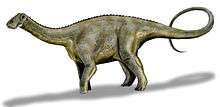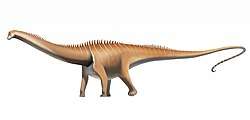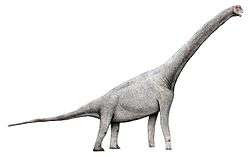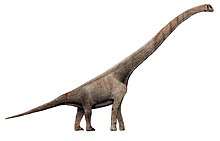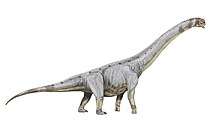Quaesitosaurus
Quaesitosaurus (meaning "extraordinary lizard") is a genus of nemegtosaurid sauropod found by Kurzanov and Bannikov in 1983. The type species is Quaesitosaurus orientalis. It lived from 85 to 70 million years ago during the Late Cretaceous (Santonian to Campanian ages). Its fossils, consisting solely of a partial skull, were found in the Barun Goyot Formation near Shar Tsav, Mongolia. Long, low and horse-like with frontally located peg-teeth, it is similar enough to the skulls of Diplodocus and its kin to have prompted informed speculation that the missing body was formed like those of diplodocids.
| Quaesitosaurus | |
|---|---|
| Diagram showing known elements | |
| Scientific classification | |
| Kingdom: | Animalia |
| Phylum: | Chordata |
| Clade: | Dinosauria |
| Clade: | Saurischia |
| Suborder: | †Sauropodomorpha |
| Clade: | †Sauropoda |
| Clade: | †Titanosauria |
| Clade: | †Lithostrotia |
| Family: | †Nemegtosauridae |
| Genus: | †Quaesitosaurus Kurzanov & Bannikov, 1983 |
| Species] | |
| |
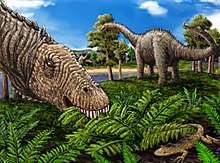
Restoration with hypothetical body
It is possible that Nemegtosaurus, also known from only skull material, is a very close relative of Quaesitosaurus.
References
- Hunt, A.P., Meyer, C.A., Lockley, M.G., and Lucas, S.G. (1994) "Archaeology, toothmarks and sauropod dinosaur taphonomy". Gaia: Revista de Geociencias, Museu Nacional de Historia Natural, Lisbon, Portugal, 10: 225–232.
- Kurzanov, S. and Bannikov, A. (1983). "A new sauropod from the Upper Cretaceous of Mongolia". Paleontologicheskii Zhurnal 2: 90–96.
External links
This article is issued from Wikipedia. The text is licensed under Creative Commons - Attribution - Sharealike. Additional terms may apply for the media files.






